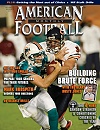Article CategoriesAFM Magazine
|
Balancing Act – Focusing on Quarterback Balance and Rhythm in Pass Dropsby: Jason MangoneOffensive Coordinator and Quarterbacks Coach, The College at Brockport © More from this issue Most emphasis on a quarterback’s pass drop is placed on depth from the line of scrimmage and the timing of the throw in conjunction with the receivers’ routes. Although these elements are vital, not enough emphasis is placed on the quarterback’s balance and rhythm within the drop. Balance is vital because we want the QB to throw as consistently as possible. Having good balance is the best way to create consistency and the right habits. Rhythm is necessary so that the QB stays under control in terms of speed and doesn’t get too fast or too slow. If the QB is too fast, often his weight will be on the back of his last step, which will cause his front shoulder to lift and throw high or will cause him to hitch up. This wastes time and may cause a late throw. Our....The full article can only be seen by subscribers.
|
|
|||||||
| HOME |
MAGAZINE |
SUBSCRIBE | ONLINE COLUMNISTS | COACHING VIDEOS |
Copyright 2025, AmericanFootballMonthly.com
All Rights Reserved





